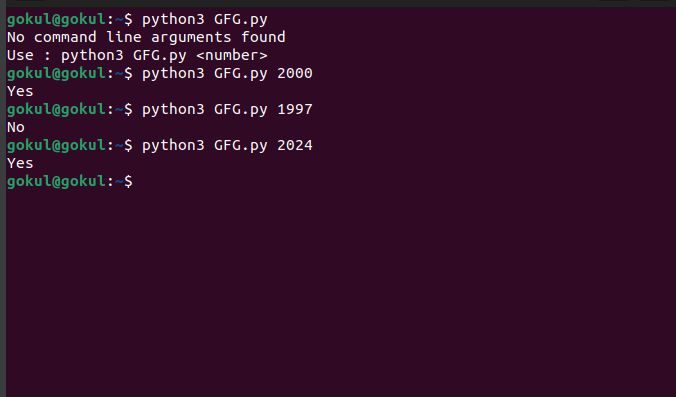TCS Coding Practice Question | Checking Leap Year
Last Updated :
05 Sep, 2023
Given a number N, the task is to check if N is a Leap Year or not, using Command Line Arguments. Examples:
Input: N = 2000
Output: Yes
Input: N = 1997
Output: No
 Approach:
Approach:
- Since the number is entered as Command line Argument, there is no need for a dedicated input line
- Extract the input number from the command line argument
- This extracted number will be in string type.
- Convert this number into integer type and store it in a variable, say N
- Now check for the below conditions:
- if N is a multiple of 400 and
- if N is multiple of 4 and not multiple of 100
Program:
C
#include <stdio.h>
#include <stdlib.h> /* atoi */
int isLeapYear(int year)
{
if (((year % 4 == 0)
&& (year % 100 != 0))
|| (year % 400 == 0))
return 1;
else
return 0;
}
int main(int argc, char* argv[])
{
int n;
if (argc == 1)
printf("No command line arguments found.\n");
else {
n = atoi(argv[1]);
if (isLeapYear(n) == 1)
printf("Yes\n");
else
printf("No\n");
}
return 0;
}
|
Java
class GFG {
public static int isLeapYear(int year)
{
if (((year % 4 == 0)
&& (year % 100 != 0))
|| (year % 400 == 0))
return 1;
else
return 0;
}
public static void main(String[] args)
{
if (args.length > 0) {
int n = Integer.parseInt(args[0]);
if (isLeapYear(n) == 1)
System.out.println("Yes");
else
System.out.println("No");
}
else
System.out.println("No command line "
+ "arguments found.");
}
}
|
Python3
class GFG:
@staticmethod
def isLeapYear(year):
if ((year % 4 == 0 and year % 100 != 0) or year % 400 == 0):
return 1
else:
return 0
if __name__ == "__main__":
import sys
if len(sys.argv) > 1:
n = int(sys.argv[1])
if GFG.isLeapYear(n) == 1:
print("Yes")
else:
print("No")
else:
print("No command line arguments found\nUse : python3 GFG.py <number>")
|
Output:
- In C:

- In Java:

- In Python

Time Complexity: O(1)
Auxiliary Space: O(1)
Share your thoughts in the comments
Please Login to comment...